Birds are Amazing
Excerpted with permission from “Birds Are Amazing” by Michael J. Parr in Bringing Back the Birds: Exploring Migration and Preserving Birdscapes Throughout the Americas, from American Bird Conservancy and nonprofit publisher Braided River. All photos by Owen Deutsch.
Birds are clearly demarcated from all other life-forms by the feathers that cloak their bodies — and while feathers are indeed unique to birds, it's what these stunning creatures can do with them that makes birds so amazing. The structure and inherent lightness of their feathers give birds the ability to fly, but birds and their feathers also come in a remarkable variety of colors and forms. Yet there's more about birds that fascinates us than their appearance: their behaviors, their intelligence, their songs. These characteristics have all evolved to help birds thrive in a diverse array of habitats and have contributed to their becoming among the most widespread of Earth's life-forms.
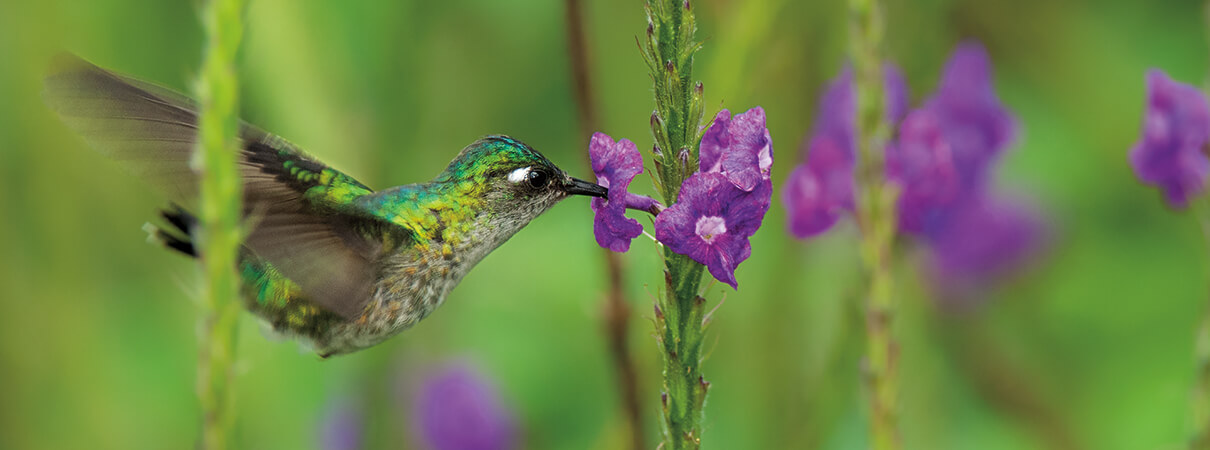
Violet-headed Hummingbird. Photo by Owen Deutsch
As diverse and well adapted as birds are, they are also fragile, and many species depend on multiple habitats being in suitable condition at the right point in their life cycles. Significant imbalances in natural systems are often first reflected in declines in bird populations. Conversely, actions that benefit birds can also provide broader benefits to the environment and, ultimately, to people. Many believe that humans should be good stewards of nature regardless of the benefits we might directly accrue, but it is clear that, whatever motivation a person has, taking care of birds and bird habitats has a range of important benefits.
Seeing a Merlin open up the throttle on a downwind sprint, it's easy to imagine that the bird partly does this for the pure thrill of speed — but flying also serves several critical survival functions. A major one is to avoid predators — and birds are brilliant exponents of the dodge-and-weave strategy to avoid attacks. Picture for a moment the aerial gymnastics it would take for a Red-eyed Vireo to enter the canopy of a fully leafed tree at full speed and emerge from the other side without hitting a single branch or twig, while evading capture by a Sharp-shinned Hawk.
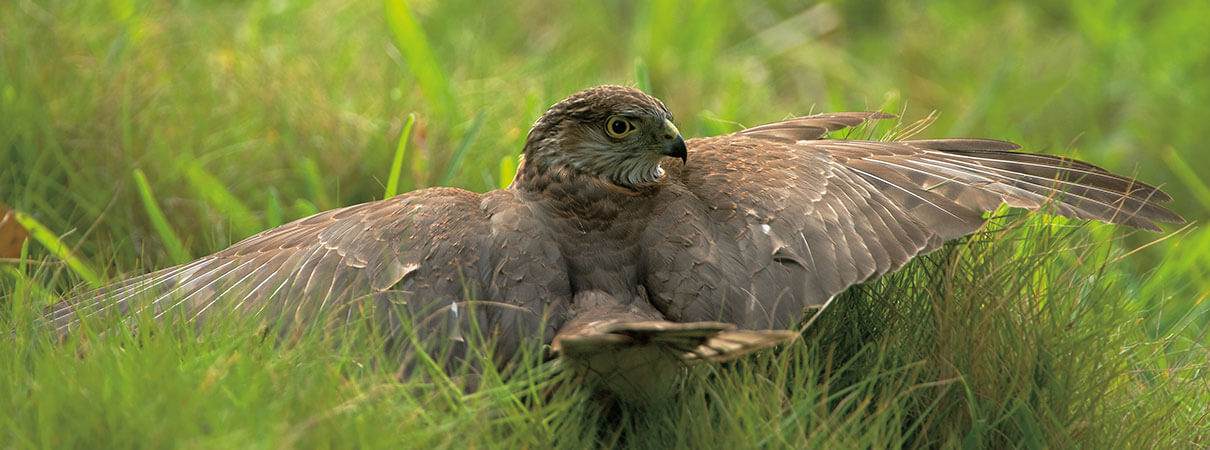
Sharp-shinned Hawk. Photo by Owen Deutsch
Then picture that same vireo flying at night across thousands of miles of land and sea to reach its wintering grounds. Birds' flight, which enables them to migrate to a variety of habitats, is also a supreme feat of endurance athletics. Among the champion flyers of the bird world, the Bar-tailed Godwit has the longest-known single-flight migration, of around 1,300 kilometers (800 miles) across the Pacific Ocean. Even this achievement is dwarfed by the approximately 80,000 kilometers (50,000 miles) traveled annually by migratory Arctic Terns.
Another dimension in flying as a survival mechanism is the ability to make extreme flight maneuvers without expending much energy. This is exemplified by birds such as the Turkey Vulture, which seems able to pivot on a dime effortlessly in midair without so much as the twitch of a flight feather. Albatrosses take this ability to its zenith, though, traveling miles across the open ocean using updrafts from wind that is hitting the waves just inches below them as they glide on the longest wings of the bird world.
But what about those birds that can't fly, such as kiwis, penguins, rheas, and ostriches? Most of them evolved in environments where predation pressure is low enough that flighted escape is unnecessary. Others are large enough or sufficiently fleet of foot to be able avoid predation in other ways: for example, ostriches can run as fast as some birds fly. In an ironic twist, these flightless species are among the most charismatic of all birds, perhaps because we sympathize with them, or maybe because we admire their ability to flourish absent the defining character of their airborne cousins. Although birds have been so successful precisely because of their mobility and ability to diversify, these factors can also make them vulnerable. Specialized species — including some flightless birds — are poorly adapted to unexpected threats such as introduced predators spread by humans or loss of specific habitats upon which they have become dependent.
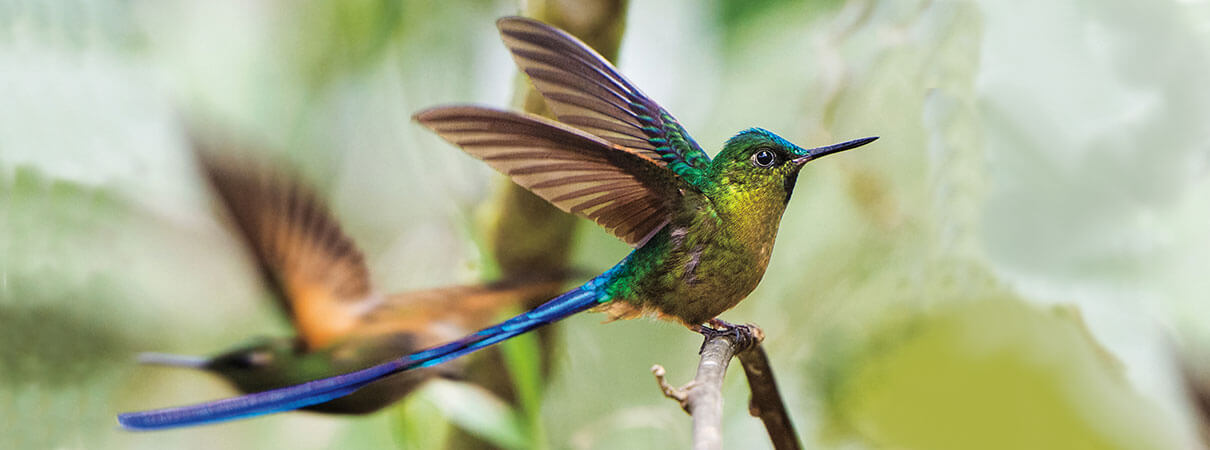
Violet-tailed Sylph. Photo by Owen Deutsch
Birds also fascinate us with their many colors, forms, and behaviors. Flick through any field guide to the birds of a Central or South American country, and your mind will be boggled by the sheer variety of hues. Look up the King Vulture, with its multicolored head; the giant macaws in red, yellow, and blue (or hyacinth, in the case of the Hyacinth Macaw); and the Day-Glo cotingas. You'll also find astonishing forms: the Horned Guan, which seems to have a volcanic plug emerging from its crown; tick-tock-tailed motmots, which wag their tails from side to side; the magnificently tailed Resplendent Quetzal; and of course the comical toucans, with their overbalanced bills that would be too heavy to lift if not for its lightweight, foamy internal lattice structure.
These features of color and form are nowhere more obvious than during birds' courtship behaviors, and some species take these displays to the extreme. One of the most entertaining and intriguing of all displays is that of the Andean Cock-of-the-Rock. The brilliant scarlet, black, and silver-gray males gather at dawn in a raucous gaggle vying to attract the more modestly hued females. Their traditional lek (mating) sites, which may be hundreds or thousands of years old, are located close to the species' preferred nesting habitat: cloud-forest streams with overhanging boulders upon which the birds affix their cup-shaped nests. Among the most appealing avian courtship displays are those of two enchanting seabirds of the Galapagos Islands. Waved Albatrosses appear to demonstrate genuine affection for each other through pair-bonding rituals that include posing, bill clappering, and head waving. The display of the Blue-footed Booby is as comical as that of the albatross is endearing. The boobies perform an overly deliberate-appearing slow-motion walk showing off their large, bright-blue feet while cocking their tails and intermittently raising their wings.
If this isn't amazing enough, some birds can literally run on water. Both Western and Clarke's Grebes perform a rushing courtship dance in which the pair undertakes a synchronized charge along the water surface with their heads raised and their feet churning the water like speedboat engines. These displays, while among the most spectacular in the bird world, are yet eclipsed by other species' courtship dances. In the group dances of the Andean Flamingo, the pink-plumaged birds strut in a tight cluster on their stilt-like legs, flicking their heads around in unison. Other remarkable dances include those of the North American grouse and cranes. Perhaps the most unusual of these is that of the Greater Sage-Grouse, in which the male inflates two large chest air sacs, erects his spiky tail, and projects what can only be described as a globbing sound as he shakes his stole-like white mane of neck feathers. Crane dances are much more elegant: the long-legged and -necked birds seem to bounce as if walking on the moon with outstretched wings as they utter their bugling calls while bowing and twisting like ballet dancers.
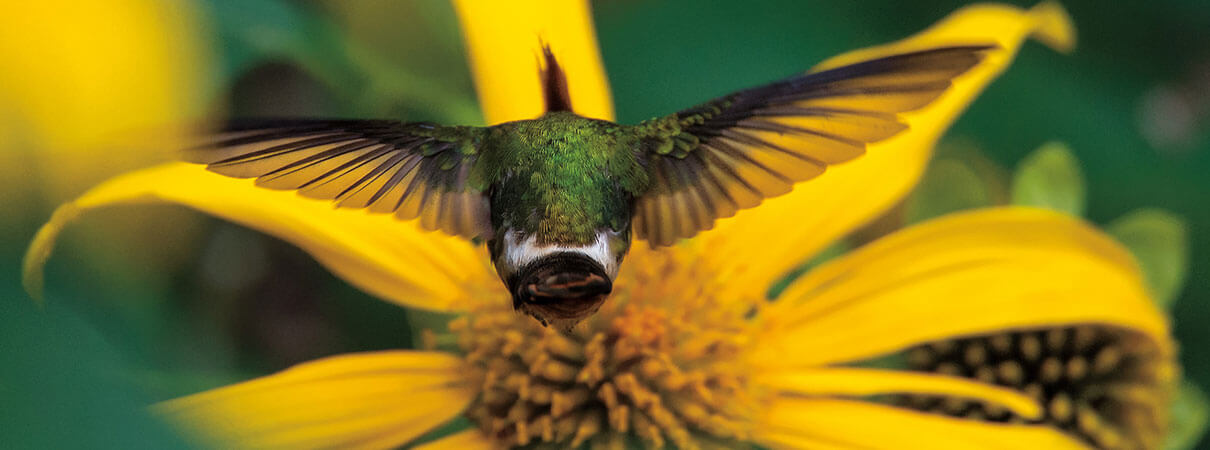
Rufous-crested Coquette. Photo by Owen Deutsch
Another feature of birds — one that people often find surprising — is how intelligent they seem to be. Owls are renowned as being “wise,” but perhaps this is more due to their appearance than their brain power. Few owls seem more scholarly than the Crested Owl, with its stunning “ears” that conjure an image of Albert Einstein. The real brainiacs of the bird world, though, are often thought to be among the Corvidae — the crow family. Not only do these birds have the largest of brains in relation to body size, they are also well known for using tools and for solving puzzles. Studies of the New Caledonian Crow reveal that the birds regularly use tools in the wild to extract grubs from rotten wood — an evolutionary development that allows the species to flourish where a less adaptable creature would not. Crows are not the only birds that use tools, however. The Woodpecker Finch of the Galapagos is also known to use tools, such as a twig or cactus spine, to dislodge grubs from tree trunks. Egyptian Vultures have been observed using rocks to break ostrich and bustard eggs, and Lammergeiers (Bearded Vultures) drop bones from a height onto rocks, to break them and access the nutritious marrow.
Birds' nests are not usually considered to be tools, but they are constructed to serve the purpose of protecting the eggs and, thus, can be regarded as some of the most complex “tools” in nature. Among the most distinctive of these nests are those of the oropendolas, which hang from trees in groups, looking from a distance like clusters of giant fruits. Perhaps the most amazing of all bird nests, though, is that of the Bald Eagle. Such nests have weighed in at as much as three tons. They can take years to build, and the birds keep adding to them over time. These huge nests can even contribute to the collapse of nesting trees during storms. Another bird whose ingenious nest building sometimes unwittingly causes the destruction of its own nest tree is the Red-cockaded Woodpecker. These woodpeckers typically bore their nests into seventy- or eighty-year-old longleaf pine trees infected with red heart fungus, which makes them easier to excavate. The genius of these nest cavities is that they cause the trees to leak resin onto the trunk that deters predatory snakes — yet, unfortunately, the cavities also make the trees vulnerable to being toppled by hurricanes that are regular events in the woodpecker's range.
Other bird behaviors suggest that there is more to a bird brain than the traditional pejorative might suggest. Birds can display complex learned behaviors based on social perception and trust; for example, scientists from the University of Cambridge in the UK discovered that scrub-jays that have previously stolen food from caches left by other jays appear to be more mistrusting of other jays. Once these mistrustful jays believe other jays have seen them in the act of food caching, these birds are more inclined to rehide their own stashes in new locations to deter anticipated thefts. Interestingly, though, these jays are more trusting of their mates — and more tolerant of their mates' pilfering.
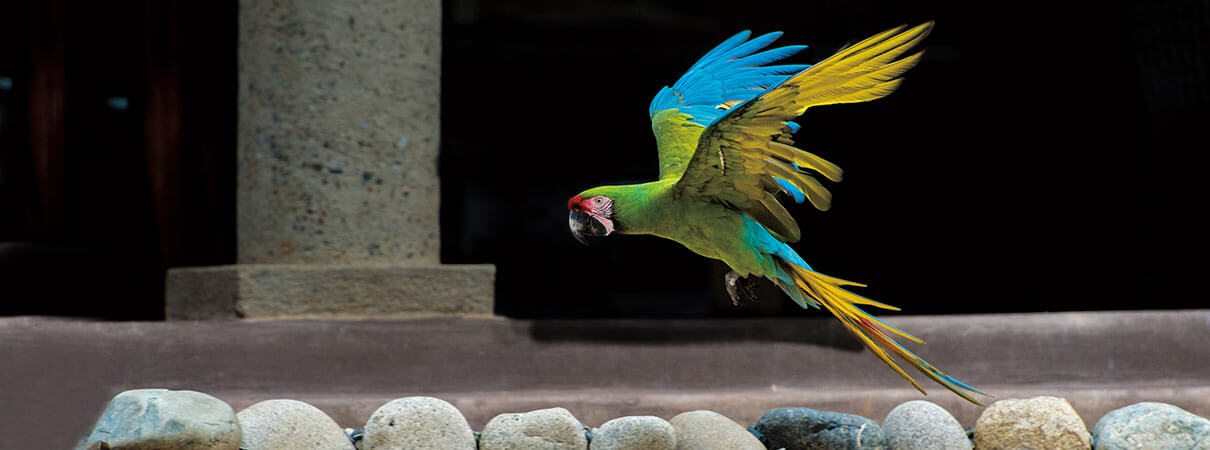
Military Macaw. Photo by Owen Deutsch
Some species play games to help them hone flying and hunting skills when every prey item counts. For example, adult Orange-breasted Falcons may lose their prey in the forest canopy if they do not grasp it securely, according to Bob Berry, director of the Peregrine Fund's Orange-breasted Falcon project. So juvenile falcons practice prey-grasping and dropped-prey recovery techniques with sticks and pine cones that they tear from tree branches. Flying over the canopy with the prize in their grasp, they engage their siblings in a game of chase. When hard pressed, a young falcon drops the object, and they all dive to retrieve the prize before it reaches the forest canopy below, then begin the game all over again.
Another really extraordinary feature of birds is their song. Fortunately for birders, each bird species has a distinctive set of calls and songs (some more distinctive than others!) that help to differentiate it from other, similar species. This is very helpful in the field if the songster cannot be easily located visually. Songs and calls serve a variety of purposes, but the main reason for birds' primary songs is the establishment of nesting territories. One of the greatest experiences in birding is that enjoyed in a North American forest during the months of May and June, when dozens of bird species can be heard singing simultaneously at dawn, all vying with others of the same species to establish their territories and each species occupying a different niche in the habitat—from the understory to the canopy — and in the food chain, from leaf gleaning to wood boring to fly catching.
Some of these songs, like that of the Wood Thrush, are just plain beautiful to listen to. Others, such as that of the Henslow's Sparrow, are barely “songs” at all — in this case, more of a “hiccup” that the uninitiated might mistake as the chirping of a cricket or other insect. Among the birds of the Americas, perhaps the most accomplished and astonishing songsters of all are the Mimidae, a family that comprises mockingbirds, thrashers, and catbirds. Some species from this family are capable of remembering and regurgitating thousands of sounds. It is common to hear mockingbirds, for example, copying the calls of species ranging from Carolina Wrens to Killdeers. This rich variety of sounds is another reason people find birds fascinating and also surprising.
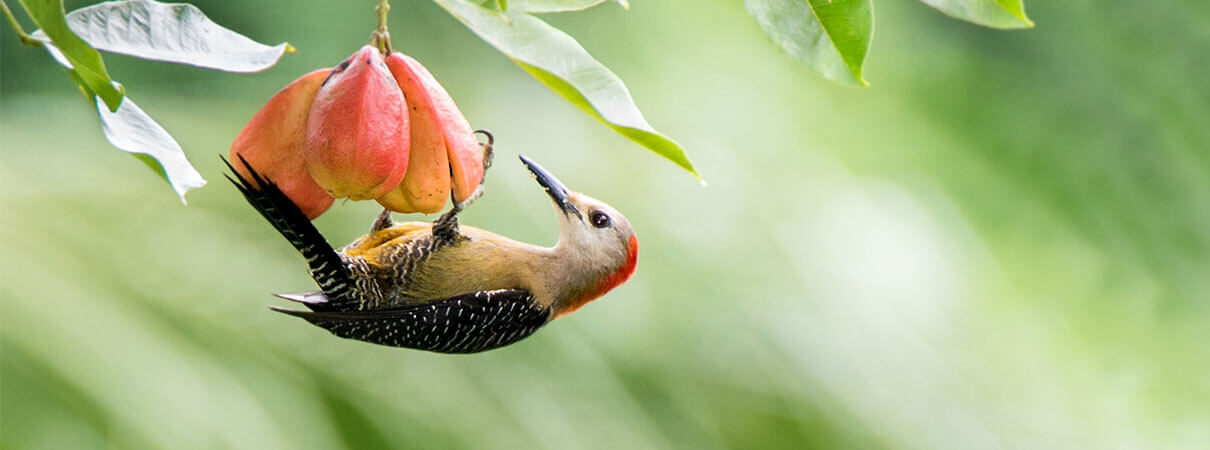
Jamaican Woodpecker. Photo by Owen Deutsch
Considering how birds combine all these survival functions — flight, color and form, display behaviors, intelligence, and song—into a single sometimes fragile-looking life-form, it's easy to realize why people are so intrigued by them. Nowhere is this appeal exhibited more spectacularly than among the hummingbirds. Many of these tiny species have spectacular and convoluted displays or lek behaviors that include elaborate flight trajectories, distinctive calls, sounds produced by both wing and tail, and flashes of jewel-like color. Hummingbirds' names also evoke their glittering colors and unusual appearance. Entire groups of hummingbirds are known as either “emeralds” or “sapphires,” and others have names such as Amethyst-throated, Garnetthroated, and even the Ruby-topaz Hummingbird. Wings and tails also feature prominently in hummingbird names, such as the large Central American Violet Sabrewing, and perhaps the best named of all birds, the truly remarkable Marvelous Spatuletail.
As interesting as hummingbirds' names are, their biology is even more unusual. Hummingbirds have among the fastest metabolisms of all animals, with heart rates reaching over 1000 beats per minute and a breathing rate of 250 inhalations over the same period. Despite this rapid metabolism, and the need to consume more nectar (often much more) than their body weight on a daily basis, a Ruby-throated Hummingbird is still capable of storing enough fat to sustain a nonstop migratory flight across the Gulf of Mexico. Hummingbirds also have the ability to almost close down their bodily systems during periods of cold — or at night — to reach a state known as torpor. In this condition, their metabolism is reduced by up to 95 percent of its usual rate, and their body temperature also drops; if you were to pick one up in this state, you might think it was dead.

Golden-tailed Sapphire (female). Photo by Owen Deutsch
When you consider all of these features bundled together, and add the surprise factor too — since, with birds, you really never know what you might see next — birds truly are amazing. As scientists wrestle with the task of proving that birds evolved from dinosaurs, the romantic in most of us has already reached our own conclusion. How can you watch the closing sequence of the movie Jurassic Park and see the phalanx of Brown Pelicans flying in tight formation across the ocean and not conclude that these creatures really are the living legacy of the dinosaurs?
As you read this book, please take time to enjoy Owen Deutsch's wonderful imagery and the great writing of some of the leaders of modern ornithology. I hope you will also be inspired to connect—or reconnect—with the birds around you and then see what you can do to help conserve these amazing creatures.
 | Michael J. Parr is President of American Bird Conservancy. |
 | Bringing Back the Birds is now available for purchase. To learn more, visit Braided River. |


















































